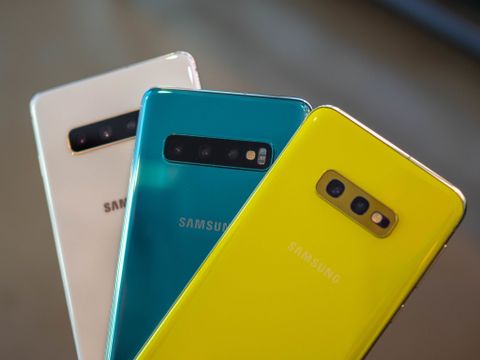Tick, tock.
The predictable thrum of time is, to a smartphone maker, the opportunity to lure customers away from their comfort, be it with an older phone of the same brand, or one from an entirely different platform. To Samsung, still the biggest handset maker in the world, the S10 series is the perfect canvas on which to convey its dominance in the building of really, really nice-looking hardware. Problem for Samsung, though: it's not the only one doing that anymore.
The Galaxy S10, S10+ and S10e are the first major phone releases in a very important year for everyone in the industry, especially its biggest player. Samsung still made boatloads of money in 2018 but the Galaxy S9 and S9+ sold in fewer numbers than the company expected, and the phones were overshadowed by hardware innovations from Huawei and camera revelations by Google.

By sight alone, the new Galaxys are undoubtedly upgrades: bigger, bright screens with less bezel; a futuristic (though divisive) hole punch notch thingy; up to three rear cameras; and plenty of small improvements to justify, or attempt to, modest price increases.
But the most interesting revelation this year may just be that there's a third Galaxy S10, dubbed the S10e, in an attempt to compete directly with the iPhone XR, and perhaps regain some of the momentum it's lost.
A Galaxy primer

This being the tenth year of Samsung's Galaxy phones, it's easy to overlook just how far the company has come. The initial batch, released in 2010, had a different design on every U.S. carrier, and Sprint's model the Galaxy S Epic 4G, even had a slide-out keyboard.
Most people didn't encounter their first Galaxy S phone until 2012's GSIII, which was a certifiable hit and sold tens of millions of units. It also set the curved. By 2015's Galaxy S6 edge, Samsung had emerged from its awkward design phase, releasing a phone with curved glass that melted into the sides of an aluminum frame. It was impressive, and went on to be one of the company's best sellers ever. The following year's flagships, the Galaxy S7 and S7 edge, established the two sizing options that we're familiar with today, with the larger one benefiting from a bigger battery and a few additional features that helped explain its inflated price.
With the S9 and S9+, Samsung was settling into a well-established routine, which could also be considered a bit of a rut. With the S10 series, it proves the run short-lived.
Galaxy S10 Hardware
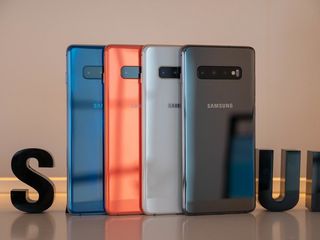
Choosing a Galaxy S10 this year is a bit more difficult than in years past. There are now three models, with a $750 S10e providing the colorful entry point to the series. It's a striking piece of hardware, mainly because its 5.8 screen belies a really small chassis — it's the same overall size as 2016's Galaxy S7. The compactness is achieved by sawing off as much of the bezel as possible and building the front-facing camera into the OLED display itself. It's a bit disconcerting at first, but we've had months to collectively prepare for this change; Samsung hinted at the move all the way back in November.
The S10e is really compact, but you lose the ultrasonic fingerprint sensor in the process.
But whereas the $900 S10 and $1000 S10+ feel a bit more like the future, the S10e is still grounded very much in the present. Its fingerprint sensor is tucked into the power button at the top right of the frame, and there are "only" two cameras on the back, a main 12MP sensor with the same variable aperture I grew to love on the Galaxy S9, plus optical image stabilization, and a 16MP ultra-wide companion camera that offers new and fun ways to shoot landscapes and groups of people.

The interesting thing is that, unlike dual-camera Galaxys of the past, all three of these new phones use the ultra-wide camera for depth instead of getting it from the telephoto. This does two things: it allows for the Galaxy S10e to, on paper, have the same quality portrait shots as the more expensive phones; and it eliminates the crop that inevitably comes with using a telephoto lens for portrait shots.
Some will argue this is a regression — traditional portraits are usually cropped closer to the subject to accentuate their face — but it lets Samsung standardize its software across the entire S10 lineup.
All Galaxy S10 models have the same camera fundamentals, but the more expensive ones add telephoto and a bit of depth.
The S10 and S10+ do have that third camera on the back, a 12MP sensor with an f/2.4 telephoto stabilized lens, once again giving the two sizes camera parity after the S9 series added a second rear camera to the larger model. Except that the S10+ does have a second front camera, too, to add depth data to selfies (and to make our lives more complicated).
Those front cameras are notable for their placement, too: as hinted by Samsung back at its developer conference in August, all three S10 models have so-called Infinity-O displays, which embed the front cameras in the AMOLED panels themselves, utilizing very precise cut-outs to ensure that there are no errant pixels or distracting aliasing. Unlike the Honor View 20, which has a hole punch on the opposite side, Samsung's cutouts are pretty discrete, though they certainly are noticeable. If you were hoping Samsung would pull a Vivo or Xiaomi by hiding the front-facing camera in a slider mechanism or motorized pop-out, you'll be disappointed.



On the Galaxy S10+, which has a larger 6.4-inch screen in nearly identical dimensions to the S9+, the two front cameras are a bit distracting, but it's nothing you won't get used to in a few hours of use. Nevertheless, the effect is notable on all three phones, and it's a testament to Samsung's manufacturing expertise that they're integrated so cleanly into the phone's front. And whereas the 6.1-inch Galaxy S10 only has a single selfie camera, it shares the same curved glass that the series has become known for.
Samsung's calling the latest iteration of its OLED technology Dynamic AMOLED, and at first glance it's considerably more vibrant than even the Note 9's Super AMOLED display. For starters, it supports HDR10+, a standard developed by 20th Century Fox to take on Dolby Vision and used in Samsung's high-end televisions. (The phones can also capture video in HDR10+, which keeps playback in the family.)
The Galaxy S10's screen isn't just good, it's good for you
It also reportedly cuts blue light output by 42% compared to previous Galaxy phones during regular use, and 99% when the software-based blue light filter is enabled. That should help some people sleep better (but only if they're actually making an effort not to use their phone before bed). Notably, while the Galaxy S10e has a lower 1080p resolution compared to the S10's 1440p, the screen quality itself isn't sacrificed for cost.



That's what makes the S10e so interesting: it's smaller, yes, but features a flattened front that, along with its minute bezels, resembles a notchless iPhone XR — at least from the front. That's probably no mistake, either: along with the Pantone-friendly Flamingo Pink color, Samsung is confidently answering Apple's call for a cheaper flagship without the traditional compromises of the "lite" models of the past.
Samsung Galaxy S10 Series Specifications
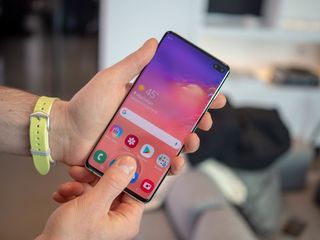
Samsung always packs its phones full of the latest technology, and the Galaxy S10 series is no different. N
Need all the numbers in one place? From screen size to RAM and storage numbers and camera details, we have all of the Galaxy S10 specifications right here.
Samsung Galaxy S10 series specifications: Everything in one place
Of course, $750 is still more expensive than the Galaxy S9's $720 debut back in March of 2018, so Samsung has to justify the cost increase somehow, right? Regardless which Galaxy S10 you choose, the phone comes with Qualcomm's latest Snapdragon 855 platform, which I tested back at CES and determined that it's the biggest year-over-year leap in performance since 2014. Each phone also comes with at least 6GB of RAM — the S10e has either 6GB or 8GB depending on the accompanying storage size of 128GB or 256GB; the S10 has 8GB of RAM and either 128GB or 512GB of storage; and the S10+ comes with 8GB of RAM with its 128 or 512GB options and an enormous 12GB with its 1TB counterpart. From a specs perspective, Samsung is not cutting any corners.
This extends to the phones' battery sizes, too: 3100mAh for the S10e, 3400 for the S10, and a massive 4100mAh for the S10+. Given that the Snapdragon 855 is considerably more efficient than its 845 predecessor, I'm cautiously optimistic that we'll finally see some decent battery life from these phones.
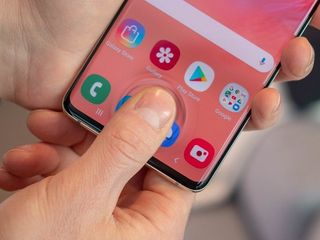
Finally, let's save the best, or perhaps most intriguing, hardware feature for last: the ultrasonic fingerprint sensor. It's only available in the S10 and S10+ — the S10e gets a somewhat perplexing side-mounted capacitive sensor/power button combo — but, based on my early testing, it's spot-on for accuracy and speed. If you recall from previous reviews, the first in-display fingerprint sensors on devices like the OnePlus 6T and Huawei Mate 20 Pro were relatively slow and unreliable, causing problems in cold or wet conditions.
Samsung's ultrasonic fingerprint sensor, which uses technology Qualcomm debuted in late 2018, relies on sound waves at frequencies higher than a human can hear, bouncing them onto a finger to create a three-dimensional map of the digit. Because it doesn't rely on light, it can't be tripped up by a wet finger or a dirty screen, and it's not nearly as temperature-dependent.
I tried and failed to trip up the in-display sensor at my briefing, and while I can't say for sure it's much faster than the current crop of capacitive options out there, it definitely seemed a bit more spritely — and more importantly, Samsung claims it's more secure.
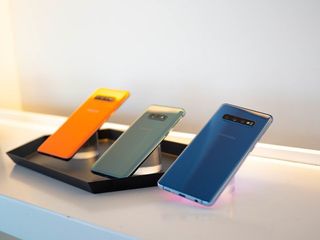
Finally, let's talk about the iterative improvements, because there are plenty.
- The Galaxy S10 sports something called Fast Wireless Charging 2.0, which raises the maximum wireless charging speeds of the S10 series to 12W, a 33% increase over the current standard. It will require a new FWC 2.0-certified wireless charger, though.
- Along with faster wireless charging, there's something called Wireless PowerShare, which lets you charge other wireless charging-compatible devices like the new Galaxy Buds, Galaxy Watch Active, and any phone with Qi charging support, at up to 4.5W. In other words, it's not fast, especially for phones, but it'll do in a pinch.
- Not only do all three S10 models have headphone jacks but all, including the S10e, have dual speaker setups with Dolby Atmos compatibility.
- Samsung is killing the iris scanner and using instead a less secure but much faster facial recognition scheme similar to many other phones out there today.
- LTE speeds have been increased to 2Gbps max, with 7CA, pending carrier support. Good luck finding a carrier to support those speeds officially, since they're all moving onto 5G.
Samsung Galaxy S10 Software
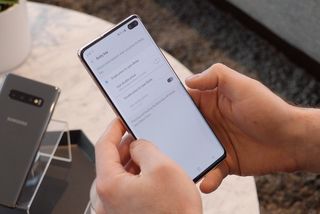
If you've read our One UI review, you know most of what to expect on the Galaxy S10, but there are a couple of surprises.
I won't bury the lede, so here goes: you can now re-assign the Bixby button to open whatever app you want. It's a compromise Samsung feels is fair, since you still can't disable the button completely — your options are to assign a single press to an app and a double press to Bixby, or the other way around. I have a feeling most people will choose the latter. (One way to "disable" it, I guess, is to assign the single press to do nothing at all, but that still leaves the double press enabled. Compromise, Samsung-style.)

There's also something called Bixby Routines, which we'll dig into more during the review. At its simplest, it's a way to build macros for Bixby commands, similar to what you can do with Alexa or Google Home today. That means you'll be able to do things like build an "In the car" Routine that disables Wi-Fi, enables Bluetooth and connects to your stereo, and begins playing your favorite podcast. All good things in theory, but we'll have to say how it plays out in practice because, well, Bixby is still pretty clunky at the best of times.
Other than that, you're getting a slightly renovated One UI 1.1 on top of Android 9 Pie. It's the best Samsung's software has ever looked, especially with Dark Mode enabled in its native apps.
The Galaxy S10 5G
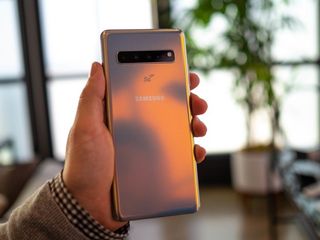
Later this year, Samsung will release the Galaxy S10 5G, a short-term Verizon exclusive before it rolls out to AT&T, T-Mobile, and Sprint in the second half of 2019.
Simply, the S10 5G is a vehicle for U.S. carriers to show off their nascent 5G NR networks while also allowing Samsung to put a bunch of crazy technology in it to justify its inevitably astronomical price.
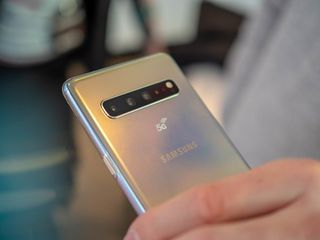

While it looks like a larger Galaxy Note 9, the S10 5G actually has a 6.7-inch Dynamic AMOLED display along with a fourth rear Time-of-Flight camera to aid with real-time video depth effects and a bunch of audacious AR plans that only 5G can reportedly enable. There's also a massive 4500mAh battery, likely necessary for 5G's additional power consumption. Finally, Samsung is building 25W Super Fast Charging into the S10 5G, which feels almost rude when you think of how much that would benefit the other S10 models.
Pricing isn't available just yet — I wasn't even allowed to hold the phone, nevermind turn it on and test it — so you'll just have to sit tight for more info on that.
Which color should you choose?

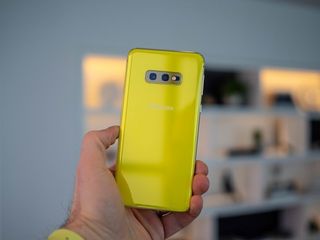
At launch, there will be four standard colors of each of the Galaxy S10e, S10 and S10+: Prism Black, Prism White, Prism Blue, Flamingo Pink
Outside the U.S., there will also be a Prism Green version, which I got a chance to hold and, well, let's just say I'm saddened by its absence in this market. Also, while I got to use a bright yellow version of the Galaxy S10e (loudly pictured above) Samsung oddly omits it from its press release, leading me to believe that it's also not going to be available in many markets.
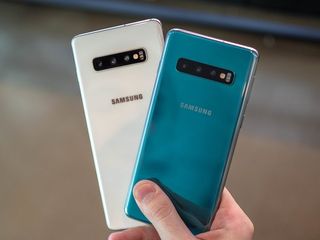

The Galaxy S10+ will also have separate Ceramic White and Ceramic Black versions for those who want to splurge on the version with 12GB of RAM and 1TB of storage (with a lofty price tag to boot). Ceramic is a relatively little-used smartphone material — at least on the outside — because it's expensive to integrate into the manufacturing process, but it's also more scratch-resistant than Gorilla Glass, and provides a unique aesthetic.
Still undecided? Use our guide to figure out which Galaxy S10 color to buy
Which model should you get?

Samsung's built a trio of really impressive, really expensive phones. This is a company working at the top of its game, and the results speak for themselves.
At the same time, Samsung isn't being shy about boosting prices, too; even if you take the S10e as the true successor to the S9 and the S10 as the successor to the S9+, that's still a $30 and $60 bump, respectively. The S10+, at $1000, now costs as much as the Note 9 when it debuted. You do get considerable value for those prices — huge bumps in RAM and storage, screen size boosts and, in the case of the S10, triple the rear cameras, among other niceties — but it may still be too rich for some people.
I'm most interested in the Galaxy S10, since I think it hits the right balance between size, battery capacity, and features. If Samsung's triple camera setup can produce solid photos and video in practically every scenario, it's going to be the phone to beat in 2019.
What about accessories?



Samsung's also announcing a few new additions to the Galaxy brand, including an updated version of its wireless earbuds, the Galaxy Buds. They're 30% smaller than the previous generation IconX, and they're now more comfortable to wear for longer periods. While they're $130 on their own, all Galaxy S10 pre-orders in the U.S. get a pair included free.

If you're into cases, Samsung has a bunch of its own, including a new-and-improved LED Cover.
If you want to pre-order a case or screen protector for the Galaxy S10 series, we have you covered here, too.
- Galaxy S10e — Best cases | Best screen protectors
- Galaxy S10 — Best cases | Best screen protectors
- Galaxy S10+ — Best cases | Best screen protectors
Pricing, Availability, and Final Thoughts

As Samsung does so well, there's only a two-week delta between pre-orders and open release: February 21 and March 8, respectively. The Galaxy S10e starts at $750 for the model with 6GB of RAM and 128GB of storage, while the S10 goes for $900 for the 8/128 model and the S10+ hits $1000 for the same loadout.
By ramping up to three (or four if you include the 5G version) models of Galaxy S10, Samsung's catering to a wider audience while also potentially confusing them. The market didn't respond kindly to Apple doing the same thing, though according to the company the iPhone XR is the best-selling device in its lineup right now, and it's not difficult to see the S10e filling that same role for Samsung.
Still, with bigger and better displays, scalable cameras and an impressive new in-display biometric solution, the mainline Galaxy S10 and S10+ are feats of engineering. Samsung may not sit alone at the top of the Android throne anymore — Huawei and other Chinese up-and-comers are nipping at its heels — but it still knows how to make one hell of an entrance.
Daniel Bader was a former Android Central Editor-in-Chief and Executive Editor for iMore and Windows Central.
